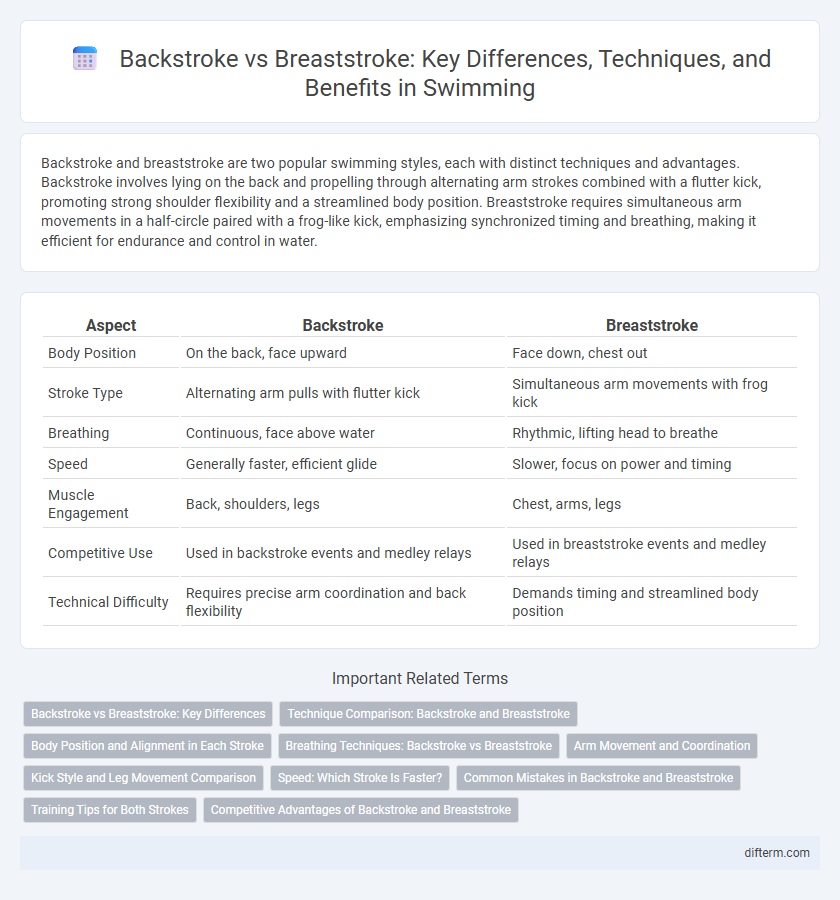Backstroke and breaststroke are two popular swimming styles, each with distinct techniques and advantages. Backstroke involves lying on the back and propelling through alternating arm strokes combined with a flutter kick, promoting strong shoulder flexibility and a streamlined body position. Breaststroke requires simultaneous arm movements in a half-circle paired with a frog-like kick, emphasizing synchronized timing and breathing, making it efficient for endurance and control in water.
Table of Comparison
| Aspect | Backstroke | Breaststroke |
|---|---|---|
| Body Position | On the back, face upward | Face down, chest out |
| Stroke Type | Alternating arm pulls with flutter kick | Simultaneous arm movements with frog kick |
| Breathing | Continuous, face above water | Rhythmic, lifting head to breathe |
| Speed | Generally faster, efficient glide | Slower, focus on power and timing |
| Muscle Engagement | Back, shoulders, legs | Chest, arms, legs |
| Competitive Use | Used in backstroke events and medley relays | Used in breaststroke events and medley relays |
| Technical Difficulty | Requires precise arm coordination and back flexibility | Demands timing and streamlined body position |
Backstroke vs Breaststroke: Key Differences
Backstroke and breaststroke differ primarily in body position and arm movement, with backstroke performed on the back and breaststroke on the chest. Backstroke features continuous alternating arm strokes and flutter kicks, enabling faster speeds, while breaststroke uses simultaneous circular arm motions and frog-like kicks, emphasizing timing and glide. These key differences impact stroke efficiency, breathing technique, and competitive performance in swimming.
Technique Comparison: Backstroke and Breaststroke
Backstroke features a supine position with alternating arm movements and a flutter kick, emphasizing continuous propulsion and streamlined body alignment. Breaststroke uses a prone position with simultaneous arm pulls and a frog-like kick, requiring precise timing and coordinated breathing for efficiency. Both strokes demand distinct muscle engagement and technique mastery to optimize speed and endurance in competitive swimming.
Body Position and Alignment in Each Stroke
Backstroke features a horizontal body position with the swimmer lying flat on their back, maintaining a streamlined alignment to reduce drag and enhance propulsion. Breaststroke requires a more undulating motion with the swimmer's body slightly angled downward during the glide phase, promoting efficient breathing and stroke timing. Proper body alignment in both strokes is critical for maximizing speed and minimizing resistance through the water.
Breathing Techniques: Backstroke vs Breaststroke
Breaststroke requires swimmers to coordinate breath intake during the recovery phase above water, emphasizing a rhythmic head lift that minimizes drag. In contrast, backstroke breathing is continuous and unobstructed, as the swimmer's face remains above the water, allowing for steady inhalation and exhalation. Mastery of these distinct breathing techniques enhances efficiency and endurance in competitive swimming disciplines.
Arm Movement and Coordination
Backstroke arm movement involves alternating circular motions where each arm pulls underwater from an overhead entry to the hip, generating propulsion while maintaining balance on the back. Breaststroke requires simultaneous arm movements pushing outward and backward in a semicircular path under the water, synchronizing with a frog-like kick for streamlined momentum. Effective coordination in backstroke demands continuous alternating strokes with rhythmic breathing, whereas breaststroke requires precise timing between the arm pull and kick to maximize lift and minimize drag.
Kick Style and Leg Movement Comparison
Backstroke uses a flutter kick with alternating leg movements that generate steady propulsion and maintain body balance on the water's surface. Breaststroke features a whip kick where the legs move simultaneously in a circular motion, providing powerful thrust but requiring precise timing for efficient glide. The backstroke's continuous flutter kick promotes speed consistency, while the breaststroke's kick emphasizes bursts of acceleration and streamlined recovery.
Speed: Which Stroke Is Faster?
Backstroke generally achieves higher speeds than breaststroke due to its streamlined body position and continuous arm movement, which reduces drag and maximizes propulsion. Elite backstroke swimmers can reach speeds of up to 1.6 meters per second, whereas breaststroke typically peaks around 1.2 meters per second because of its slower, more gliding technique and frequent pauses in arm and leg motion. Speed comparisons in competitive swimming consistently show backstroke outperforming breaststroke in terms of velocity and race times.
Common Mistakes in Backstroke and Breaststroke
Common mistakes in backstroke include improper head positioning, leading to increased drag and reduced speed, and inadequate hip rotation, which limits propulsion. In breaststroke, errors like incorrect timing of the kick and pull phases, along with a low and flat body position, cause inefficiency and slower lap times. Mastery of streamlined body alignment and synchronized movements is crucial for optimizing performance in both strokes.
Training Tips for Both Strokes
Effective training for backstroke emphasizes core strength, shoulder flexibility, and a strong catch phase to optimize propulsion and maintain a streamlined body position. Breaststroke training focuses on timing, hip rotation, and developing powerful leg kicks, with drills that enhance the glide and pull phases for maximum efficiency. Incorporating interval sets, video analysis, and specific stroke drills can improve technique and endurance for both strokes.
Competitive Advantages of Backstroke and Breaststroke
Backstroke offers competitive advantages such as faster speed due to its streamlined, face-up position and reduced drag, making it ideal for maintaining high velocity over longer distances. Breaststroke provides superior control and energy efficiency with its gliding motion and synchronous arm-leg coordination, allowing swimmers to conserve strength and excel in endurance events. Both strokes demand distinct technical skills, where backstroke favors power and rhythm for rapid lap times, while breaststroke emphasizes timing and technique for optimal propulsion.
backstroke vs breaststroke Infographic

 difterm.com
difterm.com